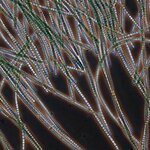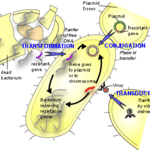Microbiology

It's winter in the northern hemisphere and that means flu season.
As influenza spreads through the northern hemisphere winter, researchers in the laboratory of Professor Jose Villadangos at the University of Melbourne believe they have a new clue to why some people fight infections better than others.
The lab has been investigating the 'defensive devices' contained within the T- cells that are located on exposed body surfaces such as skin and mucosal surfaces to ward off infection. T-cells detect cells infected with viruses and kill them before the virus can reproduce within the…

Cyanobacteria belong to the Earth's oldest organisms. They are still present today in oceans and waters and even in hot springs. By producing oxygen and evolving into multicellular forms, they played a key role in the emergence of organisms that breathe oxygen.
A team of scientists under the supervision and instruction of evolutionary biologists from the University of Zurich wrote a paper showing that cyanobacteria developed multicellularity around one billion years earlier than eukaryotes (cells with one true nucleus) and at almost the same time as multicellular cyanobacteria appeared, a…

About 200 million people across 75 of the poorest countries
in the world are now infected by the blood parasite Schistosoma haematobium (S.
haematobium). The infection causes severe urogenital disease, but also causes bladder cancer in a number of
patients and why this occurs is not clear.
Now a group of Portuguese
scientists believe they have the answer – their research shows how the parasite’s eggs can make human bladder cells behave as
cancerous cells. And the key to that – according to the first author of the work
Mónica Botelho– are catechol oestrogens, a molecule
derived from estrogen (…

In biology, you learned that the penicillin-producing mold fungus Penicillium chrysogenum only reproduces asexually through spores - it has been taught that way for much of the last century. But a group of researchers now say that the fungus also has a sexual cycle, two "genders".
In 1928, anti-bacterial researcher Alexander Fleming demonstrated (after discovering it serendipitously following years of research) the formation of penicillin in Penicillium chrysogenum. To date, there is no other known producer of that antibiotic.
Unlike in animals, sexual reproduction in fungi is not…

While many people may not be explicitly familiar with Koch's Postulates, they are generally viewed as a type of "common sense" when it comes to pathogens. Briefly the postulates consist of four criteria.
1. The microorganism must be found in abundance in all organisms suffering from the disease, but should not be found in healthy organisms.2. The microorganism must be isolated from a diseased organism and grown in pure culture.3. The cultured microorganism should cause disease when introduced into a healthy organism.4. The microorganism must be reisolated from…

In many modern discussions about bacteria, or germs, we find that novel descriptions are used that are more self-involved than accurate regarding the role of bacteria and microbes. Certainly there is an increased awareness that many microbes are commensal [or "good"] and are necessary for our well-being, while others are considered "bad" and cause disease.
However, this distorts our understanding of this relationship and helps promote some of the very ideas that foster beliefs that deny the germ theory altogether. After all, if it's about "good" versus "bad" then we have defined a…

The plague-causing bacteria Yersinia pestis evades detection and establishes a stronghold without setting off the body's early alarms but new discoveries reported this week help explain how the stealthy agent of Black Death avoids tripping a self-destruct mechanism inside germ-destroying cells.
Normally, certain defender cells are programmed to burst if they are either invaded by or detect the presence of pathogens. This host defense mechanism called pyroptosis ("going up in flames") eliminates places for the germs to reproduce. As it splits open, the cell spills antimicrobial chemicals…

A new paper says that altered gut microbiota in humans is associated with symptomatic atherosclerosis and stroke.
The human body contains ten times more bacterial cells than human cells, most of which are found in the gut. These bacteria contain an enormous number of genes in addition to our host genome, and are collectively known as the gut metagenome. How does the metagenome affect health? It's unclear, other than that probiotic foods are a $30 billion placebo. But specifics are currently being addressed by researchers in metagenomic research.
Researchers at Chalmers University…

If you are an organic food or paleo diet lover and think it means your gut microbiome resembles your ancestors in any way, you are wrong. We aren't even close to 100 years ago much less ancient times. The microbiome does not lie.
A team analyzed microbiome data from ancient human fecal samples collected from three different archaeological sites in the Americas, each dating to over 1000 years ago. They also did a new analysis of published data from two samples that reflect rare and extraordinary preservation: Otzi the Iceman and a soldier frozen for 93 years on a glacier. …

A gel similar to the amino acid that enables mussels to resist the power of churning water can be painted onto the walls of blood vessels and stay put, forming a protective barrier with potentially life-saving benefits.
Mussels have a knack for clinging to rocks, piers and boat hulls and now have inspired a gel that
can withstand the flow of blood through arteries and veins.
The gel's "sheer strength" could shore up weakened vessel walls at risk of rupturing – much like the way putty can fill in dents in a wall. By forming a stable barrier between blood and the vessel…